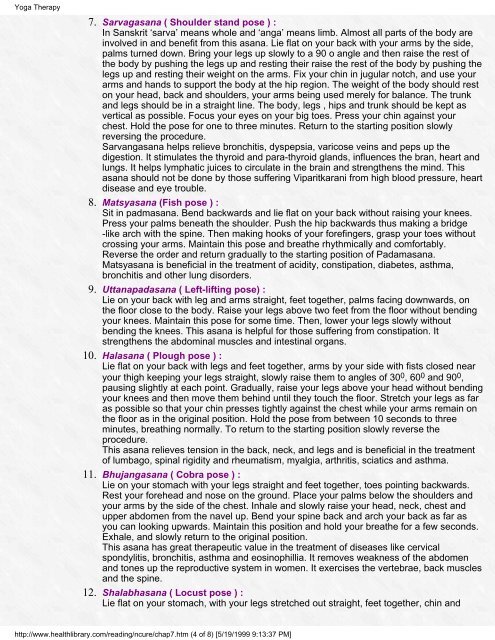A_Complete_Handbook_of_Nature_Cures
A_Complete_Handbook_of_Nature_Cures
A_Complete_Handbook_of_Nature_Cures
You also want an ePaper? Increase the reach of your titles
YUMPU automatically turns print PDFs into web optimized ePapers that Google loves.
Yoga Therapy<br />
7.<br />
8.<br />
9.<br />
10.<br />
11.<br />
12.<br />
Sarvagasana ( Shoulder stand pose ) :<br />
In Sanskrit ‘sarva’ means whole and ‘anga’ means limb. Almost all parts <strong>of</strong> the body are<br />
involved in and benefit from this asana. Lie flat on your back with your arms by the side,<br />
palms turned down. Bring your legs up slowly to a 90 o angle and then raise the rest <strong>of</strong><br />
the body by pushing the legs up and resting their raise the rest <strong>of</strong> the body by pushing the<br />
legs up and resting their weight on the arms. Fix your chin in jugular notch, and use your<br />
arms and hands to support the body at the hip region. The weight <strong>of</strong> the body should rest<br />
on your head, back and shoulders, your arms being used merely for balance. The trunk<br />
and legs should be in a straight line. The body, legs , hips and trunk should be kept as<br />
vertical as possible. Focus your eyes on your big toes. Press your chin against your<br />
chest. Hold the pose for one to three minutes. Return to the starting position slowly<br />
reversing the procedure.<br />
Sarvangasana helps relieve bronchitis, dyspepsia, varicose veins and peps up the<br />
digestion. It stimulates the thyroid and para-thyroid glands, influences the bran, heart and<br />
lungs. It helps lymphatic juices to circulate in the brain and strengthens the mind. This<br />
asana should not be done by those suffering Viparitkarani from high blood pressure, heart<br />
disease and eye trouble.<br />
Matsyasana (Fish pose ) :<br />
Sit in padmasana. Bend backwards and lie flat on your back without raising your knees.<br />
Press your palms beneath the shoulder. Push the hip backwards thus making a bridge<br />
-like arch with the spine. Then making hooks <strong>of</strong> your forefingers, grasp your toes without<br />
crossing your arms. Maintain this pose and breathe rhythmically and comfortably.<br />
Reverse the order and return gradually to the starting position <strong>of</strong> Padamasana.<br />
Matsyasana is beneficial in the treatment <strong>of</strong> acidity, constipation, diabetes, asthma,<br />
bronchitis and other lung disorders.<br />
Uttanapadasana ( Left-lifting pose) :<br />
Lie on your back with leg and arms straight, feet together, palms facing downwards, on<br />
the floor close to the body. Raise your legs above two feet from the floor without bending<br />
your knees. Maintain this pose for some time. Then, lower your legs slowly without<br />
bending the knees. This asana is helpful for those suffering from constipation. It<br />
strengthens the abdominal muscles and intestinal organs.<br />
Halasana ( Plough pose ) :<br />
Lie flat on your back with legs and feet together, arms by your side with fists closed near<br />
your thigh keeping your legs straight, slowly raise them to angles <strong>of</strong> 300, 600 and 900, pausing slightly at each point. Gradually, raise your legs above your head without bending<br />
your knees and then move them behind until they touch the floor. Stretch your legs as far<br />
as possible so that your chin presses tightly against the chest while your arms remain on<br />
the floor as in the original position. Hold the pose from between 10 seconds to three<br />
minutes, breathing normally. To return to the starting position slowly reverse the<br />
procedure.<br />
This asana relieves tension in the back, neck, and legs and is beneficial in the treatment<br />
<strong>of</strong> lumbago, spinal rigidity and rheumatism, myalgia, arthritis, sciatics and asthma.<br />
Bhujangasana ( Cobra pose ) :<br />
Lie on your stomach with your legs straight and feet together, toes pointing backwards.<br />
Rest your forehead and nose on the ground. Place your palms below the shoulders and<br />
your arms by the side <strong>of</strong> the chest. Inhale and slowly raise your head, neck, chest and<br />
upper abdomen from the navel up. Bend your spine back and arch your back as far as<br />
you can looking upwards. Maintain this position and hold your breathe for a few seconds.<br />
Exhale, and slowly return to the original position.<br />
This asana has great therapeutic value in the treatment <strong>of</strong> diseases like cervical<br />
spondylitis, bronchitis, asthma and eosinophillia. It removes weakness <strong>of</strong> the abdomen<br />
and tones up the reproductive system in women. It exercises the vertebrae, back muscles<br />
and the spine.<br />
Shalabhasana ( Locust pose ) :<br />
Lie flat on your stomach, with your legs stretched out straight, feet together, chin and<br />
http://www.healthlibrary.com/reading/ncure/chap7.htm (4 <strong>of</strong> 8) [5/19/1999 9:13:37 PM]












![[Pham_Sherisse]_Frommer's_Southeast_Asia(Book4You)](https://img.yumpu.com/38206466/1/166x260/pham-sherisse-frommers-southeast-asiabook4you.jpg?quality=85)




